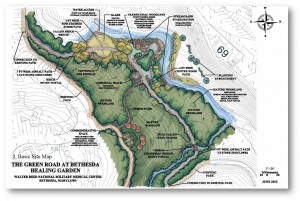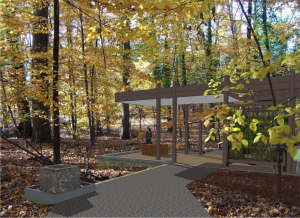
As we start to recognize the healing powers of nature, we are also seeing a rise in the popularity of healing and therapeutic gardens in hospitals, senior centers and other health care environments. These green spaces provide a place to get away from the traditional health care environment for quiet meditation, a breath of fresh air for family caregivers or a private place to grieve. The design and use of these gardens depends largely on the population served. For example, a therapeutic garden set in a hospital environment may serve a wide variety of individuals ranging from mothers and their newborn babies to family members of elderly patients in hospice care. Others may be much more specificly designed to help those grieving from a loss, abuse, physical trauma or other highly targeted population.
Soldiers returning from war are one such population. Although they share many of the needs of the general population, injured soldiers, many of whom suffer from PTSD, also require elements not found in the traditional healing garden.
According to Fred Foote, project leader at TKF Foundation partner project The Green Road being built at the Naval Support Activity Bethesda, home of Walter Reed National Military Medical Center, it starts with holistic medicine vs. conventional medicine. While conventional medicine treats one system at a time, holistic medicine looks at the entire body at once. Foote said that holistic care has become an important part of the treatment at Walter Reed.
Foote further explained that this includes infrastructure changes such as single care hospital rooms which not only reduce the spread of infection but can better accommodate family members, wellness programs (diet and exercise), and programs featuring nature, art and spirituality. “All of of the patients at Walter Reed create art or music as part of their treatment,” Foote said.
The Green Road will build upon the use of nature and spirituality in the healing process and in the process it is hoped that The Green Road will become a sacred space for injured soldiers and their families. “Every patient has a definition of sacred which is highly personal,” Foote said. “It took us nearly a year to realize that the real sacred content they wanted to emphasize was nature itself. We wanted to create something that was reverent.”
Brian Bainnson, landscape architect with TKF Foundation partner A Nature Place, has worked on healing gardens for wounded soldiers at Walter Reed National Medical Center and Ft. Belvoir. Bainnson said that the first step in designing for injured soldiers is to gain an understanding of the military culture. Comradeship and brotherhood play a big role in the military and Bainnson said that veterans need much more interaction with fellow soldiers than other patients when dealing with their injuries. “One of the things we learned is that veterans often need a place where they can be together with their fellow warriors. Gathering places to grill food, toss a Frisbee or do other things together are important. Group support among veterans is huge.” He added that this is a young population and even double and triple amputees have a vision of an active life where they can run and play so open spaces are important.
Bainnson also said that many of these soldiers have been away from their families and civilian culture for long periods of time and they need a safe space where they can interact with their families and children.
Camaraderie is an important element of the design at The Green Road. Along with a council ring where soldiers can gather with fellow soldiers and family members, The Green Road will also include a memorial aspect to allow soldiers to remember those who cannot be there. This includes artwork paying tribute to military service along with the natural elements themselves.
Rocks and stones are one natural element that will play an important role at The Green Road. “In Native American religions and others, rocks convey the spirit of nature in a particularly strong form,” Foote said. He added that they can also play a memorial role. “At Arlington National Cemetery, there are limitations to what can be left on grave sites. Soldiers often search the grounds for a stone to leave on a fallen soldiers gravestone.”
Foote explained that the natural setting of the Green Road which includes a stream, trees and animals really brings out the intrinsic healing power of nature. “The web of nature demonstrates its regenerative power and it’s ability to heal. We want soldiers to feel a sense safety; that nature will take care of you just like it takes care of the animals.”

Creating that sense of safety for soldiers requires it’s own set of design elements. According to Jack Sullivan, landscape architect for The Green Road project, “Soldiers are used to experiencing the adverse affects of dangerous situations. In combat situations, they need to ability to flee for self preservation. They need to feel that they can get out of a trapped situation,” he said. “This means that the space can have no dead ends, confinement or entrapment. Spaces must have an easy and accessible path out.” And while these access points are important to the design, Sullivan added that they are subtle and might not even be noticed by the average visitor.
“Colors can be used to help calm the heightened state of awareness found in those suffering from PTSD,” said Sullivan. By using plants and other natural elements, colors can be used to direct the eye in a way that creates relaxing, stress reducing movements.
When designing healing spaces for soldiers, Bainnson recommends that landscape architects and designers carefully and thoughtfully consider the type of plants used in the space. At one of the military bases where Bainnson worked, they realized that soldiers were making extreme efforts to avoid certain areas of the base–sometimes walking a great distance out of their way to pass around a particular location. They finally learned from psychologists working on the base that the soldiers were having a visceral reaction to palm trees and other landscape elements that reminded them of the war-torn desert environment where they had served.
Although construction of the Green Road Project is not yet completed and research has not yet begun, Bainnson said that soldiers’ response in other healing gardens has been hugely positive and that many soldiers continue to return to the gardens after recovery. “The gardens have become a place for military ceremonies and even weddings,” Bainnson said.
According to Bainnson the therapeutic effects of the gardens can be life-changing. He told the story of a soldier who had been severely injured in an IED explosion which did extensive facial damage. Although the soldier wouldn’t talk about it, his mother said that before he connected with the garden he was suicidal. Once he started visiting the garden, a transformative connection was made with the space and these suicidal thoughts lessened and eventually disappeared. This soldier is now married, owns a business and is doing well. “When you hear something like that, you can’t help but to be moved,” said Bainnson.
Research will play an important part in The Green Road project. Team researchers hope to gain an understanding as to why and how nature helps in the healing process. Foote said that just measuring the impact of nature on the body is a science in itself. Metrics such as advanced genomics, language analysis and the measurement of several stress biomarkers being measured at the same time will be used to analyze an injured soldier’s response to the natural environment of The Green Road.
“We all know in our hearts that nature heals. There is a certain artificiality to say it doesn’t” Foote said. “We hope to better understand what is really happening.” Foote added that this research goes beyond healing soldiers, “In providing this nature experience for our soldiers we are suggesting that when nature is healthy, humans are healthy. Human welfare relies on healthy ecosystems. When we have the research to back this up, then we can start to change public policy.”
